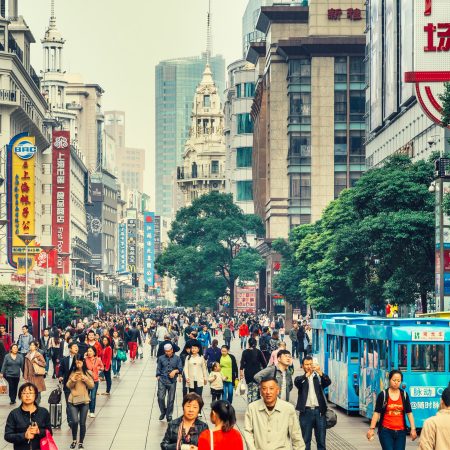If there is one thing global retailers have proved over the past two decades, it is that they are remarkably agile and resilient. The growth of e-commerce, the global financial crisis, the pandemic, a cost-of-living squeeze, extreme weather and geopolitical uncertainty have all threatened to derail the sector. Yet retail has adapted and – in some markets – thrived.
The much-forecasted wave of store closures has failed to materialise. Instead, as rents have rebased, many retailers are again expanding their store networks, leading to the return of rental growth across a number of prime retail locations. As a result, the world’s largest property investors are taking note of a sector that for a long time was a no-go area.
North America exemplifies this recovery trend. Visits to US malls were up around 1.5% in 2024 over 2023 and 7.3% compared with 2019, according to location analytics company Placer.ai. And, despite continued growth in online sales, nearly eight out of every 10 consumer dollars are still spent in a store, according to US Department of Commerce data.
“Retailers have shown remarkable resilience while navigating global economic volatility,” says Sam Foyle, Director and Co-Head of Prime Global Retail, Savills. “Retail vacancy rates in the US are at a historic low of 4.7%. Strong demand across all categories – including discount, beauty, athleisure, luxury, sport and fashion – has driven this growth. Having said this, some international brands are now pausing or slowing US expansion in response to increased global volatility and looking to Canada for greater regional exposure.”
At a US National Retail Federation (NRF) Big Show in New York in January, the bosses of Lululemon, Foot Locker and Sephora were among those to outline global expansion plans. In a further sign of conviction, real estate giant Unibail-Rodamco-Westfield opened the doors to the shopping centre at its huge HafenCity mixed-use scheme in Hamburg, Germany, in April 2025.
Demand from occupiers is driving this fresh investment and development impetus. However, the situation is complex. Just as not all retailers have successfully navigated the challenges they have faced, neither is all retail real estate immune from the trends reshaping the industry.
In North America, for example, Bed Bath & Beyond, Big Lots, Joann, Hudson’s Bay Company and Forever 21 have all entered into Chapter 11 bankruptcy – with some subsequently acquired and some not. As US retail luminary Steve Sadove, the former CEO of Saks Fifth Avenue, reflected at the NRF Big Show: “What is becoming evident is that there are winners and losers. But the idea that physical retail is dead and has become a digital play is incorrect.”
How retailers are navigating macro uncertainty
The most notable challenge for the industry remains the volatility of global economics and geopolitics. Affecting retailers and real estate alike, it is beyond the control of even the most active and focused investor.
The underlying macroeconomic backdrop has been broadly supportive of retail: falling interest rates, low unemployment in many areas of the world, improving household confidence, the global travel recovery, and rebased rents and valuations for retail space in many markets. But, of course, the early months of 2025 have brought further volatility.
Previous supply chain challenges have compelled retailers to bolster their logistics resilience, nearshore or broaden their supply chains and adopt technology to improve efficiency. The popularity of online sales has led to better integration of digital channels, with stores now playing multifunctional roles – as showrooms, fulfilment hubs and return points. Many are also investigating new revenue streams such as selling advertising to brands on in-store screens and radio. As a result, investment in stores is increasingly being seen as an opportunity.
Many retailers have already demonstrated their resilience and ability to adapt to shifting trade conditions. Lesser-known retailers and brands may use disruption as an opportunity to usurp incumbent names, while digital-native operators such as Gymshark may spy a chance to trial physical retail. The UK gymwear brand has opened a number of stores in the UK, including one on London’s Regent Street, and has further openings completed or planned for Dubai, Amsterdam and New York.
Retail occupiers are leading, investors following
There remain plenty of investors deterred by their previous forays into retail, sitting on stranded assets and having lost significant sums of money. According to the ANREV Investment Intentions Survey, global institutional allocations to retail are forecast to be 12.4% of the total in 2025, compared with 27.7% in 2018.
But investors are beginning to look at retail again. In 2024, investment was broadly stable, with momentum building in the second half of the year.
Supported by some marquee transactions, retail real estate has attracted an increasing share of institutional capital. Retail warehousing and retail parks have led this recovery – possibly because of their defensive characteristics and their ability to complement omnichannel retail strategies.
Meanwhile, asset repricing has provided interesting opportunities for investors. Yields are particularly attractive relative to other popular sectors, such as living and logistics, which need continued strong rental growth to underwrite and are relatively tightly priced due to the weight of capital pursuing them.
These trends are reflected in the latest INREV Investment Intentions Survey, which shows a significant uptick in investor interest in retail in 2025.
Major players have been readjusting their stance. In 2024, Hines publicly declared its return to retail real estate investment, saying good and bad retail had been tarred with the same brush. Westfield decided to downsize rather than sell its US mall portfolio.
In Asia Pacific, the retail sector is demonstrating growth potential, although its recovery has been mixed. Australia, Malaysia and India experienced growth in retail investment in Q4 2024 due to increased demand for regional malls. Other bright spots include US athleisure brand Vuori opening a store in Shanghai – its first in mainland China. In Japan, meanwhile, retail sales growth has been boosted by inbound tourism, while the luxury sector benefited from a weakened yen.
“We still see luxury brands expanding their store footprints, despite challenges across Asia as Chinese consumers hold back on travelling and spending,” says Nick Bradstreet, Head of Asia Pacific Retail, Savills. “This expansion will be cautious, with openings of new stores being largely within their trusted partners’ developments.
“Over the past 10-15 years, luxury groups have aligned their interests with a small group of trusted developers across Asia, which have built high-quality shopping centres and can manage and operate them over time.”
In Ireland, the country’s largest mall, Blanchardstown Centre, was purchased by investment firm Strategic Value Partners. In the UK, Redevco spent £520 million ($695 million) acquiring a portfolio of retail parks; Norway’s sovereign wealth fund Norges bought Sheffield’s Meadowhall shopping centre and a stake in Shaftesbury Capital’s Covent Garden estate; and Landsec acquired a 92% stake in the retail-led Liverpool ONE development.
“Global uncertainty has led to some sectoral cooling in Europe, but the flight to prime continues, with retailers pursuing the best locations and opportunities,” says Larry Brennan, Head of European Retail Agency, Savills. “Rightsizing is also a persistent theme, driving both opportunities and activity.
“The bellwether sectors remain sports and athleisure, along with value fashion brands, which continue to transact the highest volumes of space. The retail park sector also remains resilient, with limited availability in most markets, backed by very strong levels of demand.”
UK retail parks in particular are a standout sub-sector. Their move away from a reliance on bulky goods and furniture has seen them diversify their tenant base, adding in services such as gyms and improving the availability of restaurants and cafes. They have also attracted major fashion retailers such as Next, which was one of the first to pivot from the high street to out-of-town retail parks.
Europe and Asia Pacific: preferred sectors for investors, 2024-25
Source: INREV/ANREV Investment Intentions Survey 2025
In Spain, GDP growth of 3.2% in 2024 – driven by strong domestic consumption, resilient private investment and a surge in tourism – has created a supportive environment for investment in shopping centres. This totalled €1.1 billion ($1.2 billion) in 2024.
“Prime yields remain highly attractive, ranging between 6.5% and 7.25%, supported by robust retail sales growth, increasing footfall and stabilised capital values,” says Luis Espadas Cestero, Executive Director, Head of Retail, Savills Spain. “Banks are also showing renewed appetite to lend against retail assets, further fuelling market activity.
“With capital values often below replacement costs and limited new developments in the pipeline, supply remains constrained, creating favourable conditions for existing assets.”
Retail as operational real estate
While the lack of new development in the US and Europe is ostensibly good news for the value of existing retail real estate, the nuanced recovery requires careful asset selection by investors. Prime flagship malls and specialist sub-sectors such as retail parks and designer outlets generally continue to perform well.
But value will be far harder to extract in secondary retail destinations – for example, in locations where there is a dominant high street or super-regional mall – without significant repositioning. Investors need to consider carefully the reasons why an asset is struggling, and whether the issues relate to a lack of available capital expenditure or the fundamentals.
Equally important is the recognition that retail can no longer be viewed as a passive investment – and instead should be treated as operational real estate. Shopping destinations now require active asset management, capital for refreshment and evolution that is informed through in-depth customer insight, and focused marketing to position the centres for their catchments.
As well as considering the needs of their tenants, landlords need to understand why shoppers are coming to a mall, high street or retail park. The cookie-cutter approach of the 1980s and 1990s is no longer enough. Consumers want choice and authenticity and are looking for a mix of big brand names, local independents, bars and restaurants.
In 2025, retail is back – but not all retail. The sector’s recovery is characterised by a significant divergence between asset types, locations and management approaches. Understanding the differences between those that will thrive amid an ever-changing economic and political backdrop – and those that will not – is critical for the new wave of investors shopping for retail assets.



